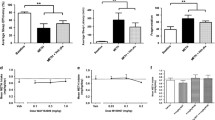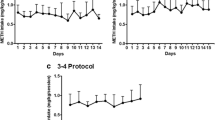Abstract
Rationale
Clinical literature suggests a link between substance abuse and sleep disturbances. Quetiapine, an atypical antipsychotic, has shown efficacy in treating sleep disturbances, with clinical studies showing promise for quetiapine as a treatment for cocaine abuse.
Objective
The goal of this study was to examine the effects of quetiapine on cocaine self-administration and behavioral indices of sleep in monkeys.
Methods
Seven adult male rhesus monkeys, fitted with Actical® activity monitors, were trained to respond under a choice paradigm of food (1.0-g pellets) and cocaine (0.003–0.3 mg/kg per injection) presentation. First, monkeys received acute pretreatment (45 min) with quetiapine (25–75 mg, p.o.) prior to choice sessions; three cocaine doses were studied in combination with quetiapine. Next, the effect of chronic (14–16 days) quetiapine treatment (25–250 mg, p.o., BID) was examined in combination with the lowest preferred cocaine dose (≥80 % cocaine choice). Behavioral indices of sleep, based on activity measures obtained during lights-out, were recorded throughout the study.
Results
Acute quetiapine decreased cocaine choice in four of the seven monkeys. Chronic quetiapine treatment resulted in initial decreases in cocaine choice, but tolerance developed to these effects. Acute doses of quetiapine did not improve sleep efficiency the following night nor did chronic quetiapine. The first night after discontinuing quetiapine treatment resulted in significant decreases in sleep efficiency and increases in nighttime activity.
Conclusions
These findings do not offer support for the use of quetiapine as a monotherapy for treatment of cocaine abuse nor as an adjunct therapy to treat sleep disturbances associated with stimulant abuse.




Similar content being viewed by others
References
Afshar M, Knapp CM, Sarid-Segal O, Devine E, Colaneri LS, Tozier L, Waters ME, Putnam MA, Ciraulo DA (2012) The efficacy of mirtazapine in the treatment of cocaine dependence with comorbid depression. Am J Drug Alcohol Abuse 38:181–186
Ancoli-Israel S, Cole R, Alessi C, Chambers M, Moorcroft W, Pollak CP (2003) The role of actigraphy in the study of sleep and circadian rhythms. Sleep 26:342–392
Andersen ML, Diaz MP, Murnane KS, Howell LL (2013) Effects of methamphetamine self-administration on actigraphy-based sleep parameters in rhesus monkeys. Psychopharmacology 227:101–107
Banks ML, Negus SS (2012) Determinants of drug choice under concurrent schedules of drug self-administration. Adv Pharmacol Sci 281768, doi: 10.1155/20212/281768
Barrett CE, Noble P, Hanson E, Pine DS, Winslow JT, Nelson EE (2009) Early adverse rearing experiences alter sleep-wake patterns and plasma cortisol levels in juvenile rhesus monkeys. Psychoneuroendocrinology 34:1029–1040
Borison RL, Arvanitis LA, Miller BG (1996) ICI 204,636, an atypical antipsychotic: efficacy and safety in a multicenter, placebo-controlled trial in patients with schizophrenia. U.S. SEROQUEL Study Group. J Clin Psychopharmacol 16:158–169
Brown ES, Nejtek VA, Perantie DC, Bobadilla L (2002) Quetiapine in bipolar disorder and cocaine dependence. Bipolar Disord 4:406–411
Brown ES, Nejtek VA, Perantie DC, Rajan Thomas N, Rush AJ (2003) Cocaine and amphetamine use in patients with psychiatric illness: a randomized trial of typical antipsychotic continuation or discontinuation. J Clin Psychopharmacol 23:384–388
Brutcher RE, Nader MA (2013) The relationship between cocaine self-administration and actigraphy-based measures of sleep in adult rhesus monkeys. Psychopharmacology 229:267–274
Cohrs S, Rodenbeck A, Guan Z, Pohlmann K, Jordan W, Meier A, Ruther E (2004) Sleep-promoting properties of quetiapine in healthy subjects. Psychopharmacology 174:421–429
Daley JT, Turner RS, Freeman A, Bliwise DL, Rye DB (2006) Prolonged assessment of sleep and daytime sleepiness in unrestrained Macaca mulatta. Sleep 29:221–231
Dolder CR, McKinsey J (2010) Quetiapine for sleep in patients with dementia. Consult Pharm 25:676–679
Food and Drug Administration (2011) Seroquel (quetiapine fumarate) medication guide. http://www.fda.gov/downloads/Drugs/DrugSafety/usm089126.pdf. Accessed 29 Jan 2013
Emsley R, Oosthuizen P (2003) The new and evolving pharmacotherapy of schizophrenia. Psychiatr Clin N Am 26:141–163
Endicott J, Svedsater H, Locklear JC (2012) Effects of once-daily extended release quetiapine fumarate on patient-reported outcomes in patients with generalized anxiety disorder. Neuropsychiatr Dis Treat 8:301–311
Fox HC, Seo D, Tuit K, Hansen J, Kimmerling A, Morgan PT, Sinha R (2012) Guanfacine effects on stress, drug craving and prefrontal activation in cocaine dependent individuals: preliminary findings. J Psychopharmacol 26:958–972
Goldstein JM (1999) Quetiapine fumarate (Seroquel): a new atypical antipsychotic. Drugs Today (Barc) 35:193–210
Hamilton LR, Czoty PW, Gage HD, Nader MA (2010) Characterization of the dopamine receptor system in adult rhesus monkeys exposed to cocaine throughout gestation. Psychopharmacology 210:481–488
Hamilton LR, Czoty PW, Nader MA (2011) Behavioral characterization of adult male and female rhesus monkeys exposed to cocaine throughout gestation. Psychopharmacology 213:799–808
Hartung DM, Wisdom JP, Pollack DA, Hamer AM, Haxby DG, Middleton L, McFarland BH (2008) Patterns of atypical antipsychotic subtherapeutic dosing among Oregon Medicaid patients. J Clin Psychiatry 69:1540–1547
Howell LL, Wilcox KM, Lindsey KP, Kimmel HL (2006) Olanzapine-induced suppression of cocaine self-administration in rhesus monkeys. Neuropsychopharmacology 31:585–593
Kampman KM, Pettinati H, Lynch KG, Sparkman T, O’Brien CP (2003) A pilot trial of olanzapine for the treatment of cocaine dependence. Drug Alcohol Dep 70:265–273
Karila L, Reynaud M, Aubin HJ, Rolland B, Guardia D, Cottencin O, Benyamina A (2011) Pharmacological treatments for cocaine dependence: is there something new? Curr Pharm Des 17:1359–1368
Kennedy A, Wood AE, Saxon AJ, Malte C, Harvey M, Jurik J, Kilzieh N, Lofgreen C, Tapp A (2008) Quetiapine for the treatment of cocaine dependence: an open-label trial. J Clin Psychopharmacol 28:221–224
Kushida CA, Chang A, Gadkary C, Guilleminault C, Carrillo O, Dement WC (2001) Comparison of actigraphic, polysomnographic, and subjective assessment of sleep parameters in sleep-disoriented patients. Sleep Med 2:389–396
Lexicomp Online (2013) Quetiapine use: labeled indications and mechanism of action. http://online.lexi.com/lco/action/doc/retrieve/docid/patch_f/7598. Accessed 29 Jan 2013
Maher AR, Maglione M, Bagley S, Suttorp M, Hu JH, Ewing B, Wang Z, Timmer M, Sultzer D, Shekelle PG (2011) Efficacy and comparative effectiveness of atypical antipsychotic medications for off-label uses in adults: a systematic review and meta-analysis. J Am Med Assoc 306:1359–1369
Malhi GS, Berk M (2002) Pharmacotherapy of bipolar disorder: the role of atypical antipsychotics and experimental strategies. Hum Psychopharmacol 17:407–412
Martinotti G, Andreoli S, Di Nicola M, Di Giannantonio M, Sarchiapone M, Janiril L (2008) Quetiapine decreases alcohol consumption, craving, and psychiatric symptoms in dually diagnoses alcoholics. Hum Psychopharmacol 23:417–424
Morgan PT, Pace-Schott EF, Sahul ZH, Coric V, Stickgold R, Malison RT (2006) Sleep, sleep-dependent procedural learning and vigilance in chronic cocaine users: evidence for occult insomnia. Drug Alcohol Depend 82:238–249
Morgan PT, Pace-Schott EF, Sahul ZH, Coric V, Stickgold R, Malison RT (2008) Sleep architecture, cocaine and visual learning. Addiction 103:1344–1352
Nader MA, Green KL, Luedtke RR, Mach RH (1999) The effects of benzamide analogues on cocaine self-administration in rhesus monkeys. Psychopharmacology 147:143–152
National Institutes of Health (2005) State-of-the-science conference statement on manifestations and management of chronic insomnia in adults. http://consensus.nih.gov/2005/insomniastatement.htm
Negus SS (2003) Rapid assessment of choice between cocaine and food in rhesus monkeys: effects of environmental manipulations and treatment with d-amphetamine and flupenthixol. Neuropsychopharmacology 28:919–931
Philip NS, Mello K, Carpenter LL, Tyrka AR, Price LH (2008) Patterns of quetiapine use in psychiatric inpatients: an examination of off-label use. Ann Clin Psychiatry 20:15–20
Pinkofsky HB, Hahn AM, Campbell FA, Rueda J, Daley DC, Douaihy AB (2005) Reduction of opioid-withdrawal symptoms with quetiapine. J Clin Psychiatry 66:1285–1288
Potvin S, Kouassi E, Lipp O, Bouchard RH, Roy MA, Demers MF, Gendron A, Astarita G, Piomelli D, Stip E (2008) Endogenous cannabinoids in patients with schizophrenia and substance abuse disorder during quetiapine therapy. J Psychopharmacol 22:262–269
Prieto E, Mico JA, Meana JJ, Majadas S (2010) Neurobiological bases of quetiapine antidepressant effect in the bipolar disorder. Actas Esp Psiquiatr 38:22–32
Puhl MD, Fang J, Grigson PS (2009) Acute sleep deprivation increases the rate and efficiency of cocaine self-administration, but not the perceived value of cocaine reward in rats. Pharmacol Biochem Behav 94:262–270
Ravindran AV, Al-Subaie A, Abraham G (2010) Quetiapine: novel uses in the treatment of depressive and anxiety disorders. Expert Opin Investig Drugs 19:1187–1204
Reeves RR, Brister JC (2007) Additional evidence of the abuse potential of quetiapine. South Med J 100:834–836
Regier DA, Farmer ME, Rae DS, Locke BZ, Keith SJ, Judd LL, Goodwin FK (1990) Comorbidity of mental disorders with alcohol and other drug abuse. Results from the Epidemiologic Catchment Area (ECA) study. J Am Med Assoc 264:2511–2518
Riedel M, Muller N, Strassnig M, Spellmann I, Severus E, Moller HJ (2007) Quetiapine in the treatment of schizophrenia and related disorders. Neuropsychiatr Dis Treat 3:219–235
Robert S, Hamner MB, Kose S, Ulmer JG, Deitsch SE, Lorberbaum JP (2005) Quetiapine improves sleep disturbances in combat veterans with PTSD. J Clin Psychopharmacol 25:387–388
Sadeh A (2011) The role and validity of actigraphy in sleep medicine: an update. Sleep Med Rev 15:259–267
Sadeh A, Acebo C (2002) The role of actigraphy in sleep medicine. Sleep Med Rev 6:113–124
Sadeh A, Hauri PJ, Kripke DF, Lavie P (1995) The role of actigraphy in the evaluation of sleep disorders. Sleep 18:288–302
Sattar SP, Bhatia SC, Petty F (2004) Potential benefits of quetiapine in the treatment of substance dependence disorders. Rev Psychiatr Neurosci 29:452–457
Schutte-Rodin S, Broch L, Buysee D, Dorsey C, Sateia M (2008) Clinical guideline for the evaluation and management of chronic insomnia in adults. J Clin Sleep Med 4:487–504
Sheehan DV, Locklear J, Svedsater H, Datto C (2012) Long-term functioning and sleep quality in patients with major depressive disorder treated with extended-release quetiapine fumarate. Int Clin Psychopharmacol 27:239–248
Strakowski SM, DelBello MP (2000) The co-occurrence of bipolar and substance use disorders. Clin Psychol Rev 20:191–206
Tassniyom K, Paholpak S, Tassniyom S, Kiewyoo J (2010) Quetiapine for primary insomnia: a double blind, randomized controlled trial. J Med Assoc Thai 93:729–734
Volkow ND, Fowler JS, Wang GJ, Goldstein RZ (2002) Role of dopamine, the frontal cortex and memory circuits in drug addiction: insight from imaging studies. Neurobiol Learn Mem 78:610–624
Volkow ND, Wang GJ, Telang F, Fowler JS, Logan J, Wong C, Ma J, Pradhan K, Tomasi D, Thanos PK, Ferre S, Jayne M (2008) Sleep deprivation decreases binding of [11C]raclopride to dopamine D2/D3 receptors in the human brain. J Neurosci 28:8454–8461
Volkow ND, Tomasi D, Wang GJ, Telang F, Fowler JS, Logan J, Benveniste H, Kim R, Thanos PK, Ferre S (2012) Evidence that sleep deprivation downregulates dopamine D2R in ventral striatum in the human brain. J Neurosci 32:6711–6717
Wiegand MH, Landry F, Bruckner T, Pohl C, Vesely A, Jahn T (2008) Quetiapine in primary insomnia: a pilot study. Psychopharmacology 196:337–338
Wine JN, Sanda C, Caballero J (2009) Effects of quetiapine on sleep in nonpsychiatric and psychiatric conditions. Ann Pharmacother 43:707–713
Woods JH, Herring S, Winger G (1978) Chlorpromazine- and haloperidol-induced changes in some behavioral effects of cocaine and amphetamine. In: Deniker P, Radouco-Thomas C, Villeneuve A (eds) Neuro-Psychopharmacology. Pergamon Press, Oxford, pp 1485–1502
Woolverton WL, Balster RL (1979) The effects of lithium on choice between cocaine and food in the rhesus monkey. Commun Psychopharmacol 3:309–318
Woolverton WL, Balster RL (1981) Effects of antipsychotic compounds in rhesus monkeys given a choice between cocaine and food. Drug Alcohol Dep 8:69–78
Acknowledgments
We would like to thank Tonya Calhoun and Michael Coller for excellent technical assistance and Dr. Paul Czoty for comments on an earlier version of this manuscript. This research was supported by the National Institute on Drug Abuse grants DA025120 and DA012460.
Conflict of interest
The authors declare no conflicts of interest.
Author information
Authors and Affiliations
Corresponding author
Rights and permissions
About this article
Cite this article
Brutcher, R.E., Nader, M.A. Effects of quetiapine treatment on cocaine self-administration and behavioral indices of sleep in adult rhesus monkeys. Psychopharmacology 232, 411–420 (2015). https://doi.org/10.1007/s00213-014-3672-5
Received:
Accepted:
Published:
Issue Date:
DOI: https://doi.org/10.1007/s00213-014-3672-5




